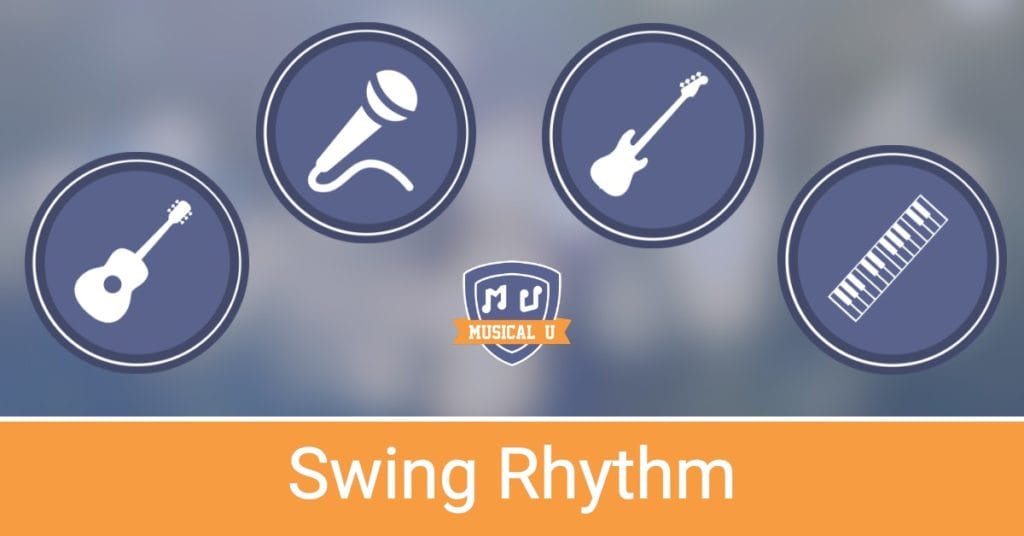First described as “swing” during the heyday of jazz as the popular dance music in the 1930s, patterns of uneven eighth-note rhythms (long short long short long short long short) can now be found in many styles of pop, jazz, rock, country, blues, and more. But how do you learn to swing rhythm when it seems to be more like a feel or an art rather than something that can be clearly notated?
In the 30s, 40s, and 50s the jaunty rhythm of swing was everywhere – watch an old movie and it even seems like people walk and talk in swing time. But as those generations are moving on the rhythm that felt as natural as dancing in the rain must be learned rather than absorbed from the swinging shepherds or the rockin’ robins dancing in and out of the collective imagination of a bygone era.
Yet there’s nothing old-fashioned about swing. Rockers who grew up on the stuff perpetuated this rhythmic feel, and it pops up continually in pop, country and other music styles – they can all claim roots in swing anyway. Jazz continues its unstoppable forward motion, and lovers of dance continue to spur swing music revivals.
In this month’s Instrument Packs Musical U’s Resident Pros for guitar, piano, and bass “do the math” on swing rhythms, with videos, PDFs, and MP3s that line out structured sequences of exercises to get you up and swinging.
Piano
Resident Pro Sara Campbell breaks down the mysterious “feel” of swing with simple mathematical concepts – until this rhythmic style becomes more clear and accessible. She also clears up many sight-reading issues that pianists typically encounter when reading music in swing rhythm, especially regarding pick-up notes, sixteenths and other rhythmic complexities:
Including:
- What Exactly is Swing Rhythm? How to feel (and count!) swinging 8th notes.
- Counting Complex Rhythms: What to do with triplets, single 8th notes, and 16th notes.
- Swing Rhythm Exercises: three exercises to help you with common swing rhythms.
- Playalong MP3 backing tracks to sharpen your syncopation skills
Banish the fear of the “Swing Feel” marking on your sheet music, and bring your piano playing to life with Sara’s swinging Resource Pack.
Singing
We mostly identify the particular rhythmical feel known as “swing” with a certain style of music and a certain time period: the swing era (1930s/40s). But swing persists in many styles and genres. Guest Pro Nina Rosenberger shows how to “Swing it” with your voice:
Including:
- The theory and practice of swing rhythm.
- How to apply swing to songs, and to take a song from “straight” to “swingin'”.
- Listening links to examples of different styles of swing.
- Three unique exercises to get you started with this rhythmic concept
- Backing tracks for your exercises.
A little study of rhythmic transcription – and how to translate this with your voice – will get you singing and swinging in various styles and intensities.
Bass
The bass plays a unique part in swing, holding down a walking bass line. But even that straight 4/4 groove has to swing! As you bass-heads know, everybody’s counting on you and the details make all the difference. Join Resident Pro Steve Lawson as he takes you on a bass “walk to remember” through Swingtown:
Including:
- Swing Basics: Differentiation between the theoretical and the stylistic/applicable.
- Different Types of Swing: Swing feel (4/4), shuffle (12/8), and walking bass swing styles.
- The Walking Bass: How to play the most prevalent swing bass pattern.
- Practice Exercises and Backing Tracks: combining typical chord progressions with swing explorations
With this Swing Rhythms pack, you’ll learn how bass holds down the foundation and keeps the music swinging. Steve also points out that not all swing is created equal (ok, by definition none of it is equal – but we’re talking swing styles here). So Steve’s important stylistic tips will make sure you don’t wear out your welcome at the jam session.
Guitar
Swing rhythm feel varies considerably from blues to rock to jazz. To add complexity to complexity, swing style varies from artist to artist and even from tempo to tempo within a genre. Resident Pro Dylan Welsh does the math and breaks it all down – as he shows you where to start on your guitar to explore these different feels while remaining right “in the pocket” with your rhythm:
Including:
- Swing Basics: The definition of swing and what it sounds like.
- Interpreting Swing: How a swing rhythm is commonly interpreted (incorrectly), and how to break it down properly.
- Unique Styles: The reason why the best players have their own unique swing “feel.”
- Exercises: A few scale exercises to help you get into the rhythm at different speeds while never losing the beat.
Geek out on Dylan’s awesome metronome trick and discover your own unique swing feel with this month’s Guitar Resource Pack.
Coming up next month…
Next month is “Improvisation Month” here at Musical U. Our resident pros will be exploring how to take your improvised explorations and transform them into music to remember with a keen awareness of musical phrasing and form.
Interested in getting access to these resources and much more, with an Instrument Pack membership? Just choose that option during checkout when you join Musical U, or upgrade your existing membership to get instant access!







